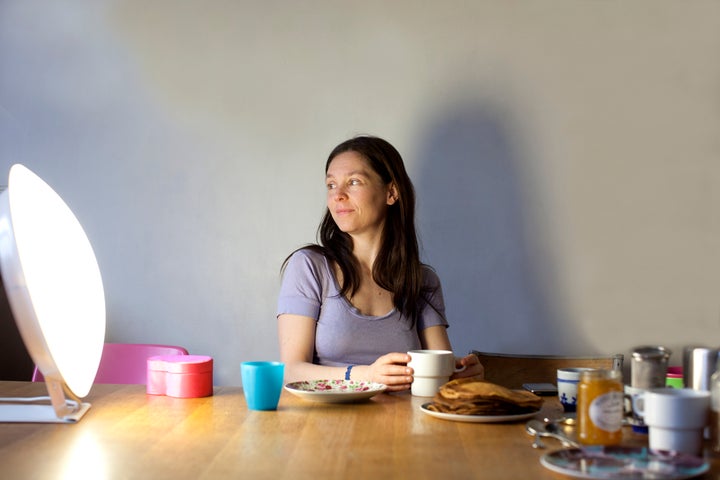It’s not groundbreaking information that we’re all finding ourselves indoors more right now. Add that to the colder, darker days ahead and you may notice yourself feeling a little more moody or blue than usual.
“Most people don’t think much about light on a day-to-day basis, but human physiology and mood adapts to the light we receive,” said Hanne Hoffmann, an assistant professor of animal science at Michigan State University with a background in neurobiology.
“In the summer people get a lot of natural light and this promotes changes in the body, allowing an increased sense of well-being, more energy and an overall good mood,” she said. “In the fall, when most people spend less time outside combined with shorter days, many do not get enough natural light to maintain those ‘feeling happy’ brain signals and may experience seasonal affective disorder.”
Enter: SAD lamps, clinically referred to as light therapy boxes. The tool mimics outdoor light and can help mitigate some of the mental health problems that come with the wintertime.
“Common signs of SAD include lack of energy, reduced motivation, trouble concentrating, feeling down as well as being grumpy, moody or anxious,” Hoffmann said. “You might eat more and gain weight. Your sleep quality is often reduced, and you might sleep more, but still feel tired when you get up.”
If you are diagnosed with SAD or are experiencing symptoms, data shows light therapy will help 80% of those who use it correctly.
But do a quick search on Google or Amazon for a SAD lamp and you’ll find a swinging scale of prices, ranging from $30 to over $100. So what’s the difference? Do you need to shell out a bunch of cash on the product in order for it to work?
Here, experts explain what makes SAD lamps so effective and what to look for before you buy one.
How SAD lamps work to improve your mental health
“Light therapy may normalize individuals’ circadian rhythms by stimulating retinal cells, which consequently affect the hypothalamus, a portion of the brain involved in the regulation of many important bodily functions,” said Leela R. Magavi, a psychiatrist and regional medical director of Community Psychiatry in California. These functions include sleep cycles, emotions and appetite.
But it’s not as simple as turning on a desk lamp to instantly improve your mood. SAD lamps provide a close match to natural sunlight ― specifically, high-intensity white light, which is measured in lux (short for luminous flux per unit area).
“Most homes with standard light bulbs will give you a light intensity of approximately 300 to 1,000 lux,” Hoffmann explained. “This is actually rather dim when compared to natural light. Bright sunlight at noon easily can be greater than 100,000 lux, whereas light intensity on an overcast day will be around approximately 1,000 to 2,000 lux. In the winter, outdoor light intensity can be much lower depending on where you live.”
It’s this intense white light that can improve SAD symptoms, and making sure the light is bright enough is key.

All SAD lamps are not created equal, which is why a higher-end model may end up being better
While brighter is better, there are a few other qualities your SAD lamp should have, which may increase the price.
“A high-quality light box will provide light at 10,000 lux when the light box is placed 12 inches or more from the eyes or face and will have a UV filter to avoid the risk of retinal damage,” Hoffmann said.
This is where you’ll need to do some research as a consumer, Magavi said. SAD lamps aren’t FDA approved and don’t require a prescription to purchase, so you won’t be steered toward a specific model. In addition to brightness, certain lamps that provide convenience due to their shape and size may also increase the price, she added.
This isn’t to say that a less expensive SAD lamp won’t work, however. It may just take longer to see the benefits.
Both Hoffmann and Magavi recommend sitting near a SAD lamp (about 16 to 24 inches away from it) first thing in the morning anywhere between 20 to 90 minutes for five to seven days per week. If the lamp you purchase isn’t 10,000 lux, you’ll want to lean more heavily toward 90 minutes per day, or as long as possible, depending on your morning routine.
“Remember not to look straight into the lamp,” Hoffmann said. “Put it at an angle next to your computer screen or place it on the table next to you. If you love cooking, hang it on the wall in the part of the kitchen where you spend the most time.”
It’s also important to turn it off after 12 p.m. to avoid messing up your sleep cycles.
“Some of the more expensive light box models allow you to be further away from the lamp and still experience 10,000 lux,” Hoffmann said. “So if you have a set up where you can be close to the light box, you will still get the full benefits of the light treatment with a cheaper model.”
The one place you can save money? SAD lamps that are blue light-enriched. Research published in BMC Psychiatry found both bright white and blue light therapy treatments to be equally as effective, though some lamps with blue light may boast a higher price tag.
Whatever model you end up choosing, make sure you also use it in combination with other positive mental health habits. Going outside for a few minutes a day, moving your body in a way that feels good, maintaining your social connections (even virtually) and trying to stick to a routine will help in these bleak winter months. And, if your emotions still feel too difficult to manage, there’s nothing wrong with talking to a mental health professional.